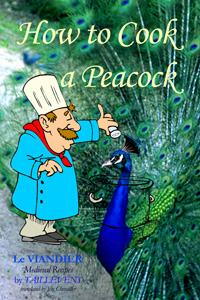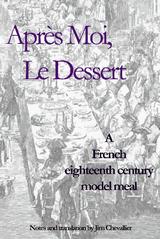CHEZ JIM
BOOKS |
August Zang How Viennoiserie Came to France
|

|
Until 2009, the history of the croissant centered on a siege of Vienna and Marie-Antoinette. Then this book appeared. Since then an increasing number of sources have acknowledged the role of August Zang and his Boulangerie Viennoise in making the croissant French. The work has been cited in several books:
and on a number of Web sites [some now inactive]:
Years after it first appeared, this book - now in its THIRD edition! - remains the only in-depth account of how this Austrian artillery officer brought the croissant to France - and transformed French baking in the process. |
a printed copy of the book, click HERE. |
Or read it in minutes with
|
The birth of the croissant
In late 1839, the French writer Saint-Beuve wrote to a friend: “We are all to go eat
some cake Tuesday at a very splendid and very delectable Viennese bakery.” This Viennese bakery - Boulangerie Viennoise - had been opened by an Austrian artillery officer, August Zang. Among other typical Austrian fare, Zang's bakers made kipfel, the crescent-shaped roll that had existed in Austria since at least the thirteenth century. Soon French "Viennese bakeries" opened, and made what the French called a "crescent", or croissant. But the bakery's influence went well beyond introducing this iconic pastry, and August Zang would go on to immense success, not in baking, but as a press magnate.
Some samples from the book
"Though many authors do not even bother to mention the distinction,
older tales about the croissant in fact concern the kipfel. In such tellings,
the kipfel is essentially treated as being a croissant under another name.
This is not unlike discussing the mammoth and calling it an elephant. How
many croissants, like the “pinnacle-cake” cited above, contain lard?
In fact lard is still used for some kipfel today. Kipfel also have long
been made in a wide variety of ways, often being covered, for instance, in
salt, anise seed, caraway, etc."
"Culinary history is full of colorful tales. Even prominent food historians are often happy to repeat some picturesque account of a food's
origin without, it seems, doing the most fundamental research to verify it. The two stories examined here are not the only ones told regarding the French croissant, but they are by far the most widely repeated."
"At the mid-point of the nineteenth century, references to the croissant
began to appear in France:
I have found nothing [in London] comparable to our first quality of
split white breads, to our so-called coffee rolls, to our fancy rolls
called viennese, of dextrin, gruau, croissants...(1850)"
"August Zang began his adult life as an officer and ended it as a wealthy
banker and mine-owner. His involvement in the bakery business was brief,
a way-station on the road to his real success, and possibly even an
embarrassment to him in later years. Future generations might have found
this ironic, had those most affected not been blissfully unaware of his
impact on their daily life."
Table of Contents
- The Kipfel
- Croissant Myths
- The Siege of Vienna
- Marie-Antoinette
- Enter, the Croissant
- August Zang, "Baker"
- The Boulangerie Viennoise
- Innovations
- Zang's Influence
- Elegance and Upgrades
- The Baguette
- Toward the Modern Croissant
- The Father of the Daily Vienna Press
- Girardin
- Die Presse
- Zang, the Man
- After Die Presse
- "The Well-Bread Count"
- Meanwhile, Back in Paris
- APPENDIX A - Early Croissant Recipes
- Urbain Dubois' 1868 recipe for original croissants
- Majac's recipe for laminated croissants
- Scheibenbogen's 1896 recipe for laminated croissants
- Sylvain Goy's 1915 recipe for laminated croissant
- Favrais' 1904 recipe for laminated Croissants
- APPENDIX B - Die Presse Obituary for Zang
- APPENDIX C - Von Zurzabach on Zang
- APPENDIX D - The Pain au Chocolat/Chocolatine
- NOTES
And now, two follow-ups (on-line) to the book
(for lovers of bread and baking history):
About the Baguette
And....
From Appleton's Journal of Literature, Science and Art (1872):
In 1848, a man appeared in Vienna who has entirely revolutionized
journalism in the Austrian capital. This bold reformer, the father of
the daily Vienna press of today, was neither a littérateur of
extraordinary ability nor a poor journalist, favored by Fortune, but a
baker, named August Zang.
This man, while residing in Paris, where he did an excellent business
with Wiener Kipfeln and Kaisersemmeln (different kinds of fine
bread), had made himself as throughly acquainted as possible with
the editorial and administrative departments of the Parisian journals.
He took especial pains to study the system on which Emile Girardin
conducted his paper, La Presse; and when, on his return to Vienna,
he saw the condition journalism was in throughout the whole empire,
he promptly decided to start a paper upon the Girardin plan. This he
did in 1848, calling his paper Die Presse.
All text and translations copyright 2009 Jim Chevallier.
Please do not reproduce or post elsewhere without prior permission.
Interested in historical cuisine? Here are three other books from Chez Jim:
Yes,
the French kings really did eat peacocks - and swans, and herons, and
blackbirds too. Taillevent, the cook who served two of them, not only cooked
these dishes, but left a book on how to do it. He called it Le Viandier.
In this new translation, it's called:
How To
Cook A Peacock
·
For recreational
medievalists
·
For lovers of
culinary history
·
For students of
medieval life
·
For adventurous cooks
Have you ever wanted to make an eighteenth century meal? This book, starting with a menu from a classic French cookbook, tells you how. Even if you don't have a house full of servants and a kitchen with numerous hearths, you'll find enough original French eighteenth century recipes - newly translated - here to entertain a number of guests in true eighteenth century style.
This collection includes recipes for game, veal, beef, chicken and various sauces, salads and other tasty items, worth making on their own or as part of a full, elegant period meal.
The second volume in this series presents VEGETARIAN recipes from Old Regime France. No, it's not a modern gimmick - in Catholic France, meat was forbidden on some days, and so one of the choices was this "meal of roots"; including not only carrots, parsnips, beets, turnips, etc., but also lentils and peas, onions, artichokes and asparagus.
This collection includes over 100 recipes for soups, stews, salads, sweets, even... mock fish, made from vegetables of every sort (and even a fish or two).
UPDATED: Febraury 9, 2025
In late 1839, the French writer Saint-Beuve wrote to a friend: “We are all to go eat some cake Tuesday at a very splendid and very delectable Viennese bakery.” This Viennese bakery - Boulangerie Viennoise - had been opened by an Austrian artillery officer, August Zang. Among other typical Austrian fare, Zang's bakers made kipfel, the crescent-shaped roll that had existed in Austria since at least the thirteenth century. Soon French "Viennese bakeries" opened, and made what the French called a "crescent", or croissant. But the bakery's influence went well beyond introducing this iconic pastry, and August Zang would go on to immense success, not in baking, but as a press magnate.
Some samples from the book"Though many authors do not even bother to mention the distinction,
older tales about the croissant in fact concern the kipfel. In such tellings,
the kipfel is essentially treated as being a croissant under another name.
This is not unlike discussing the mammoth and calling it an elephant. How
many croissants, like the “pinnacle-cake” cited above, contain lard? I have found nothing [in London] comparable to our first quality of split white breads, to our so-called coffee rolls, to our fancy rolls called viennese, of dextrin, gruau, croissants...(1850)" "August Zang began his adult life as an officer and ended it as a wealthy banker and mine-owner. His involvement in the bakery business was brief, a way-station on the road to his real success, and possibly even an embarrassment to him in later years. Future generations might have found this ironic, had those most affected not been blissfully unaware of his impact on their daily life." |
Table of Contents
And now, two follow-ups (on-line) to the book And.... |
From Appleton's Journal of Literature, Science and Art (1872): In 1848, a man appeared in Vienna who has entirely revolutionized journalism in the Austrian capital. This bold reformer, the father of the daily Vienna press of today, was neither a littérateur of extraordinary ability nor a poor journalist, favored by Fortune, but a baker, named August Zang. |
All text and translations copyright 2009 Jim Chevallier.
Please do not reproduce or post elsewhere without prior permission.
Interested in historical cuisine? Here are three other books from Chez Jim:
|
Yes,
the French kings really did eat peacocks - and swans, and herons, and
blackbirds too. Taillevent, the cook who served two of them, not only cooked
these dishes, but left a book on how to do it. He called it Le Viandier.
In this new translation, it's called: How To
Cook A Peacock ·
For recreational
medievalists ·
For lovers of
culinary history ·
For students of
medieval life ·
For adventurous cooks
|
Have you ever wanted to make an eighteenth century meal? This book, starting with a menu from a classic French cookbook, tells you how. Even if you don't have a house full of servants and a kitchen with numerous hearths, you'll find enough original French eighteenth century recipes - newly translated - here to entertain a number of guests in true eighteenth century style. This collection includes recipes for game, veal, beef, chicken and various sauces, salads and other tasty items, worth making on their own or as part of a full, elegant period meal. |
The second volume in this series presents VEGETARIAN recipes from Old Regime France. No, it's not a modern gimmick - in Catholic France, meat was forbidden on some days, and so one of the choices was this "meal of roots"; including not only carrots, parsnips, beets, turnips, etc., but also lentils and peas, onions, artichokes and asparagus. This collection includes over 100 recipes for soups, stews, salads, sweets, even... mock fish, made from vegetables of every sort (and even a fish or two). |
UPDATED: Febraury 9, 2025


